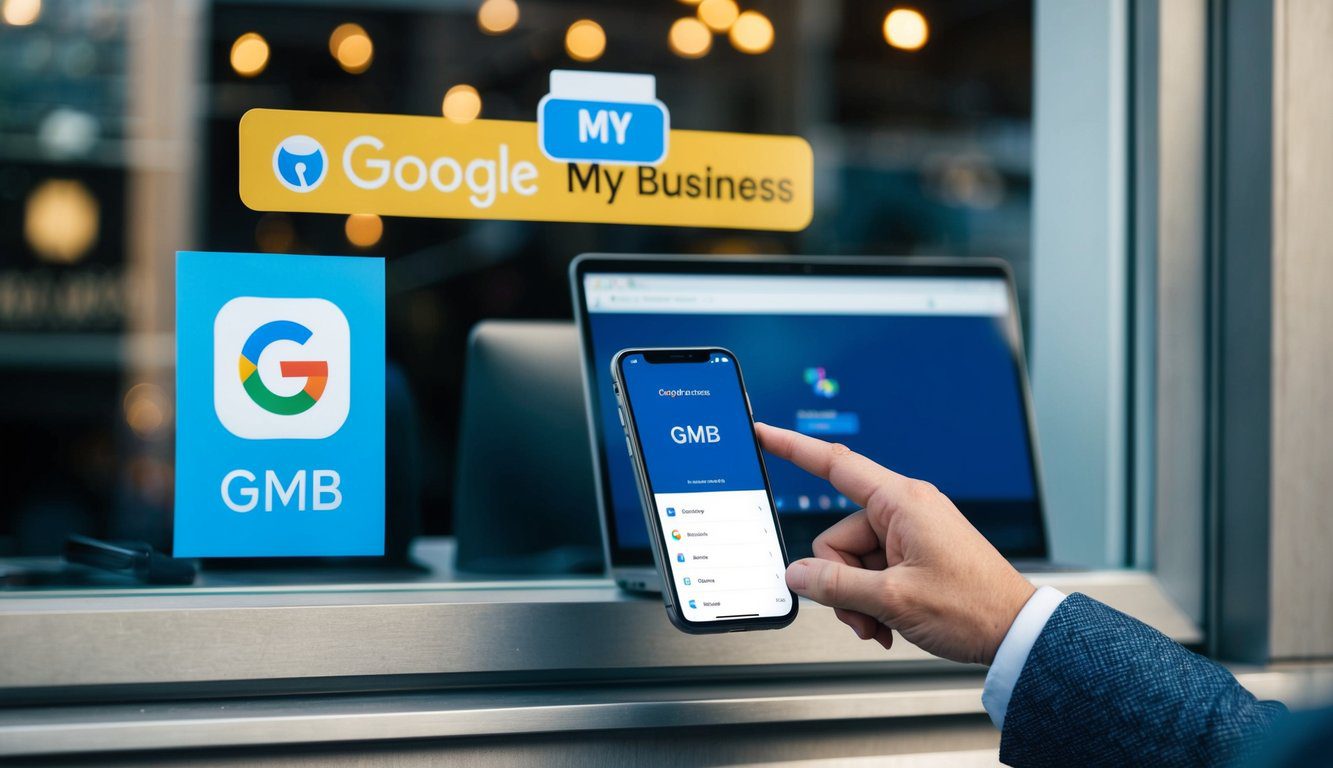Table of Contents
Google My Business labels are a handy tool for organizing your business listings. They help you group and manage multiple locations or aspects of your business easily. Labels are tags you can add to your Google My Business profile to categorize and sort your listings more efficiently.
These labels are only visible to you and don’t show up in public searches. You can use them to track different types of businesses, mark seasonal locations, or group franchises. This feature is especially useful if you manage several business listings or have multiple locations.
By using labels, you can save time and effort when updating or reviewing your business information. They make it simpler to find specific listings and apply changes across similar groups. Labels are a powerful way to streamline your Google My Business management and keep your online presence organized.
Key Takeaways
- Labels help you organize and manage your Google My Business listings
- You can use labels to group similar businesses or locations for easier updates
- Adding labels to your GMB profile can save time when managing multiple listings
Understanding Google My Business
Google My Business is a free tool that helps local businesses manage their online presence. It allows you to connect with customers and control how your business appears on Google Search and Maps.
Basics of GMB
Google My Business lets you create a business profile with key information. You can add your business name, address, phone number, website, and hours. Photos and videos help showcase your products or services. You can also post updates, respond to reviews, and answer customer questions.
To get started, claim your business listing or create a new one. Verify your business through mail, phone, or email. Once verified, you can edit your info anytime.
GMB offers insights on how customers find and interact with your listing. You can see search queries, views, and actions like website visits or calls.
Importance for Local Businesses
A complete GMB profile boosts your local search visibility. When people search for businesses like yours, Google may show your listing in results or on Maps. This helps potential customers find you easily.
GMB gives you direct control over your business info. You can quickly update hours, add photos, or share news. This keeps customers informed and engaged.
Reviews on your GMB listing build trust. You can respond to feedback, showing you value customer opinions. Positive reviews can attract new customers and improve your local search ranking.
Google My Business vs. Google Business Profile
In late 2021, Google renamed Google My Business to Google Business Profile. While the name changed, the core features remain the same.
The main difference is how you manage your listing. Previously, you used a separate GMB dashboard. Now, you can edit your Business Profile directly on Google Search or Maps when signed in.
For single locations, this new approach is simpler. Multi-location businesses can still use the old dashboard, now called Business Profile Manager.
The change aims to streamline the process of managing your online presence. It puts your business info where customers already look for it – on Search and Maps.
Setting Up Your Business on GMB
Creating a Google My Business profile is key to boosting your online presence. The process involves setting up your listing, verifying your business, and using the dashboard to manage your profile.
Creating Your Business Listing
To start, go to the Google Business Profile website. Click “Manage now” and sign in with your Google account. Enter your business name and choose your category. This helps customers find you when searching for similar businesses.
Next, add your location. If you have a physical store, put in your address. For service areas, you can list the regions you cover.
Add your contact details, including phone number and website. Make sure this info is correct and up-to-date. You can also set your business hours here.
Verification Process
Google needs to confirm you own your business. This step is crucial for your listing to show up in search results and on Google Maps.
You’ll usually get a postcard with a code sent to your business address. When it arrives, log into your account and enter the code.
Some businesses might be able to verify by phone or email. Google will let you know if these options are available to you.
Verification can take a few days to a couple of weeks. Be patient and check your mail regularly.
Business Dashboard
After verification, you’ll get access to your Google My Business dashboard. This is your control center for managing your listing.
Here you can:
- Update your business info
- Post updates and offers
- Add photos and videos
- Respond to reviews
- See how customers find and interact with your listing
Check your dashboard regularly. Keep your info fresh and respond quickly to customer reviews. This helps improve your visibility in Google searches.
Use the Insights tab to see how your listing performs. You’ll find data on views, searches, and customer actions. This info can help you improve your online strategy.
Labels in Google My Business
Labels are a useful tool for organizing and managing your business listings on Google My Business. They help you categorize and group locations, making it easier to find and update information.
What Are Labels
Labels in Google My Business are tags you can add to your business listings. You can assign up to 10 labels per location, with each label having a maximum of 50 characters. These labels are only visible to you and not to the public.
Labels act like keywords for your internal use. You might use labels like “franchise,” “seasonal,” or “new location” to quickly identify specific types of businesses in your account.
To add labels, go to your Google My Business dashboard, select a location, and look for the label option. You can create new labels or choose from existing ones.
Benefits of Using Labels
Using labels in Google My Business offers several advantages for managing your business locations. Labels make it easier to sort and filter your listings, especially if you have multiple locations.
You can use labels to:
- Group similar businesses
- Track promotional campaigns
- Identify locations needing updates
- Manage seasonal businesses
Labels also help with advertising campaigns. You can ensure the right locations and call extensions show up in your ads by using specific labels.
For multi-location businesses, labels streamline management tasks. You can quickly find all stores in a certain region or all locations offering a particular service.
Managing Business Information
Google My Business lets you control how your business appears online. You can add key details and adjust settings to improve your listing.
Adding and Updating Information
To edit your business info, go to your Google Business Profile. Click “Edit profile” in Google Search or Maps. You can update basics like your name, address, and phone number.
Add your opening hours, website, and description. Include photos to show off your business. Keep everything up to date.
You can set special hours for holidays. Add services or products you offer. Make sure to fill out all relevant sections.
Advanced Information and Settings
For more options, look for “Advanced information” in your profile. Here you can add labels to organize your listing. Labels help you group similar businesses if you manage multiple locations.
You can set service areas if you travel to customers. Add attributes to highlight features like “wheelchair accessible” or “free Wi-Fi”.
Check your verification status. A verified listing looks more trustworthy. You can also manage who has access to edit your profile in the advanced settings.
Optimizing for Local Searches
Google My Business labels help you rank higher in local searches. They boost your visibility and make it easier for nearby customers to find you. Here’s how to use them effectively.
Improving Visibility in Search Results
To show up more often in local searches, fill out your Google My Business profile completely. Add your business name, address, and phone number. Pick the right categories for your business. Use keywords in your description that people might search for.
Add photos of your business, products, and services. Fresh content helps you rank better. Ask happy customers to leave reviews. More positive reviews can improve your local ranking.
Update your hours regularly, especially for holidays. This helps customers know when you’re open. It also shows Google your profile is active.
Using Google Ads with Your GMB Profile
Google Ads can boost your local search presence. Link your Google My Business profile to your Google Ads account. This lets you use location extensions in your ads.
Create ads that target people near your business. Use local keywords in your ad text. For example, “pizza delivery in Brooklyn” instead of just “pizza delivery”.
You can use labels to organize your listings in Google Ads. Labels help you group similar locations. You might label stores by region or type of service. This makes it easier to create targeted ad campaigns.
Interaction with the Google Maps App
Many people use Google Maps to find local businesses. Make sure your business shows up correctly on Maps. Check that your address is exact and your pin is in the right spot.
Add attributes to your listing. These tell people important info at a glance. You might show that you offer free Wi-Fi or have outdoor seating.
Respond to questions people ask through Maps. Quick, helpful answers make you look good to potential customers. They also give Google more info about your business.
Keep your photos updated on Maps. Add pictures of your storefront so people can find you easily. Show off your products or menu items to attract more customers.
Using Labels for Organization
Labels help you sort and manage your Google Business listings. They make it easy to group similar businesses, track performance, and handle multiple locations.
How to Add Labels to Your Listing
To add labels, go to your Google Business Profile. Click on “Info” and find the “Advanced Information” section. Look for the “Labels” option. Click it to start adding labels.
You can create new labels or use existing ones. Think about what makes sense for your business. Some ideas:
- Business type (restaurant, retail, service)
- Location (downtown, suburban, mall)
- Special features (wheelchair accessible, pet-friendly)
Use clear, specific labels. This helps you find listings quickly later. You can add up to 10 labels per listing.
Managing Labels for Multiple Locations
Labels are very useful if you have many business locations. You can use them to group similar outlets. This makes it easier to update info or track performance.
Here are some tips:
- Use consistent labels across locations
- Create a labeling system (e.g. [City]-[BusinessType])
- Review labels regularly to keep them up-to-date
You can also use labels to mark franchise locations or different brands under one company. This helps you stay organized as your business grows.
Analyzing Performance with Labels
Labels can help you track how different types of locations are doing. You can use them to compare performance across groups.
For example, you might want to see:
- How urban vs. suburban locations are performing
- If certain business types get more views or actions
- Which regions have the highest customer ratings
To do this, go to your Google Business Profile insights. Filter your data by label. This lets you spot trends and make smart decisions about your business strategy.
Remember to check your label performance regularly. This helps you understand what’s working and where you might need to make changes.
Best Practices for GMB Labels
Labels help you organize your Google Business Profile effectively. Use them wisely to manage multiple locations or service areas.
Keep your labels short and simple. Aim for 1-3 words that clearly describe the category or feature.
Be consistent with your naming conventions. This makes it easier to search and filter your listings later.
Use labels to group similar businesses. For example, “Pizza” for all your pizza restaurants or “24/7” for locations open round the clock.
Don’t overdo it. Stick to 10-15 labels max to avoid confusion. Quality matters more than quantity.
Update your labels regularly. As your business changes, so should your labeling system.
To add or edit labels:
- Go to your Business Profile
- Click “Info”
- Scroll to “Advanced Information”
- Click “Edit” next to Labels
- Add or remove labels as needed
For service area businesses, use labels to indicate coverage zones. This helps you track which areas you serve.
Remember, labels are for internal use only. Customers don’t see them, so focus on what helps you manage your listings better.
Regularly review your labels to ensure they still make sense for your business structure and goals.
Frequently Asked Questions
Labels in Google Business Profile help organize and manage multiple business locations. They offer practical benefits for businesses with several branches or franchises. Let’s explore some common questions about using labels effectively.
How can I add labels to my Google Business Profile to organize multiple locations?
To add labels, go to your Google Business Profile dashboard. Select the location you want to label. Click on “Info” and scroll down to find the “Labels” section. Enter your desired label and click “Apply”. You can add multiple labels to each location.
Labels help you group similar locations together. This makes it easier to manage and update information across related listings.
What is the purpose of labels in managing my business listings on Google?
Labels let you organize and categorize your business locations. They’re useful for filtering and finding specific listings quickly. You can use labels to group locations by region, type of service, or any other criteria that makes sense for your business.
Labels also help with bulk updates. You can apply changes to all locations with a certain label at once.
Can you provide examples of effective label usage for Google My Business?
Some effective label examples include:
- Geographic labels: “Northeast”, “West Coast”, “Downtown”
- Service type: “Full-Service”, “Express”, “Drive-Thru”
- Brand divisions: “Luxury Line”, “Budget Friendly”, “Premium”
Use labels that make sense for your business structure. Choose clear, consistent naming conventions for your labels.
Are labels visible to the public when I add them to my Google Business Profile?
No, labels are not visible to the public. They’re only for internal organization and management. You can use them freely without worrying about customer confusion.
Labels help you streamline your workflow behind the scenes. They don’t affect how your business appears in search results or on Google Maps.
What steps should be followed for bulk uploading locations with labels on Google My Business?
To bulk upload locations with labels:
- Prepare a spreadsheet with your location data, including a column for labels.
- Go to the Google Business Profile dashboard and select “Add location”.
- Choose “Import locations” and upload your spreadsheet.
- Review and confirm the information.
- Submit your locations for verification.
Make sure your labels are consistent across all entries in the spreadsheet.
How do labels in Google My Business differ from tags in other Google services like Google Ads?
Labels in Google Business Profile are specific to organizing business locations. They don’t affect ad targeting or performance like Google Ads tags do.
Google Ads tags are used for campaign management and reporting. Business Profile labels focus on internal organization of your physical locations or service areas.
Both help with organization, but they serve different purposes in their respective platforms.










